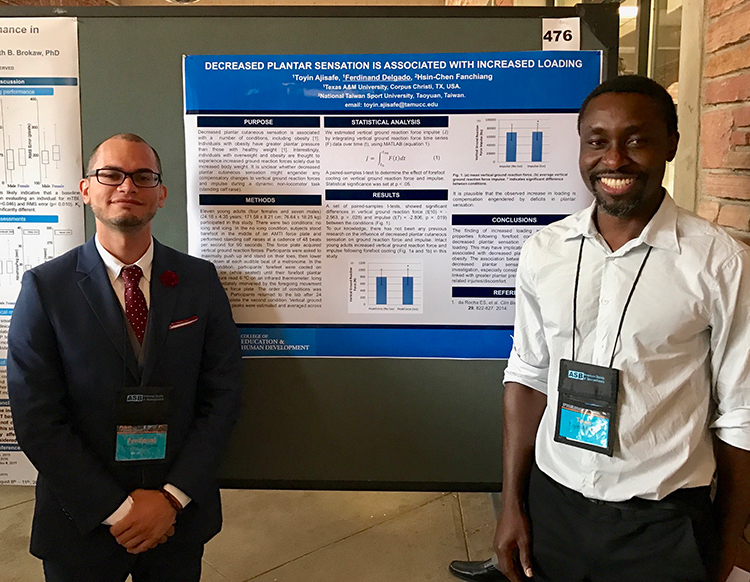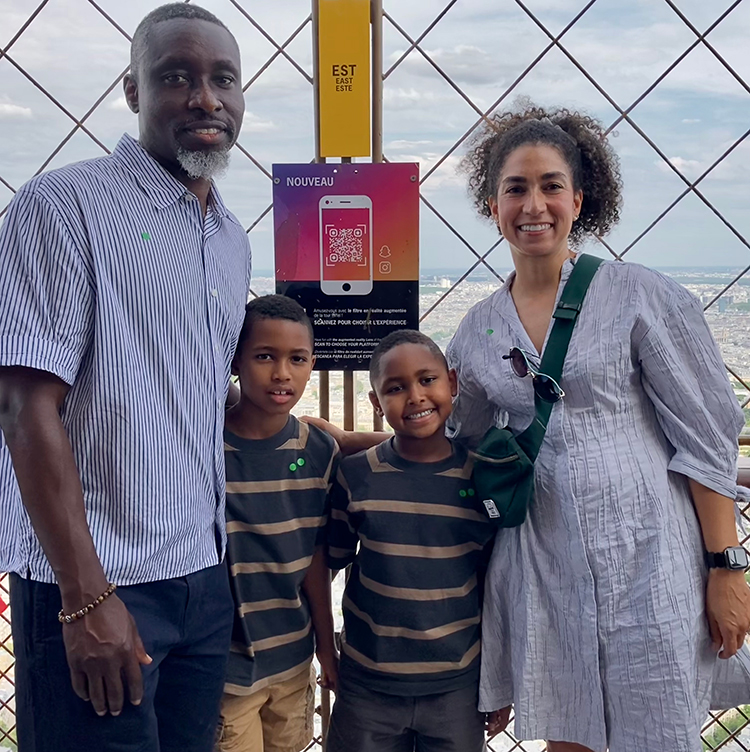What sparked your interest in science?
Early on, I enjoyed reading and was fascinated by anatomy. I was always interested in the human body and health, and I would dig through my dad’s books from college. When I was 12 or 13, I asked my dad to give me a four-volume set of medical encyclopedias.
In Nigeria, where I grew up, medicine, engineering, and law tend to be the prestigious majors going into college, so naturally I fell into that. I started college in Nigeria as a medical student and did two years of medicine before moving to the United States.
Why did you leave Nigeria, and what led you to a research path in the United States?
At the time, public universities in Nigeria had unionized faculties, and there were many strikes related to wages. My dad recommended I go elsewhere, so I targeted a place with a low cost of living – Grand Forks, North Dakota. I soon realized that in the United States, I had to get an undergraduate degree before medical school. As an international student, I wasn’t eligible for loans, so medical school went out the window. I earned bachelor’s degrees in physical therapy and exercise science because they are close to medicine. In retrospect, the distance from the cultural pressures I grew up with was beneficial, because it turns out I didn’t like clinical work.
I’m an introvert, and during my first year in the physical therapy program I discovered that I didn’t enjoy working in a clinic. The small talk felt like a chore to me, it was repetitive, and I didn’t feel like I was being helpful. But I took a biomechanics course and connected with it right away – the physics of it was more appealing. I decided to change course and leave North Dakota’s cold climate for Miami. That led to a master’s degree in movement science and subsequently a Ph.D. program in biomechanics in Atlanta, Georgia.
How did your focus evolve during and after your doctoral program?
My mentor at Georgia State University was Jerry Wu, Ph.D. , who was instrumental in shaping my course. I was his first Ph.D. student, so we grew together. His research focused on children with intellectual and developmental disabilities, and it felt meaningful for me to engage with children with Down syndrome. The work involved trying to understand the movement challenges that these children experience and using those insights to inform technological approaches to address those issues. It solidified my interest in research and how it can have impact. Dr. Wu was also applying for NIH grants, so I received exposure to grant writing.
My wife and I had our first son just before I defended my dissertation. I took a faculty position at Texas A&M in Corpus Christi, and while interviewing there, I noticed that childhood obesity was a problem. As a researcher, you want to create a separation between you and your mentor’s research to show independence. For me the question was: Do I change the population I’m working with? So, I made connections, and it became clear that I could contribute to childhood obesity research. I was very active going into schools and volunteering for health fairs.
How did you apply your expertise in kinesiology and biomechanics to childhood obesity and health?

I was working on a few fronts. For example, there are fundamental movement skills, such as running, jumping, and hopping, that inform a child’s capacity for physical activity. Children with, or who are at risk for, obesity may experience reduced sensation on the bottom of their feet, resulting in difficulty with and less willingness to engage in activities that challenge their balance. Therefore, it’s hard to quantify how often they use these fundamental movement skills; activity trackers don’t accurately capture these movements. I was interested in understanding the structure of physical activity: During the course of a day, how often do kids jump or hop? We created an insole with vibration and machine learning algorithms to improve sensation on the bottom of the foot and capture these movements.
I also pursued inclusive game development that would set gameplay objectives based on the child’s ability – for example, how fast they can run or how high they can jump. The game also captured the structure of physical activity, particularly related to fundamental movement skills. Traditional games don't give you those metrics, so we developed a low-cost game where kids used jumping, hopping, ducking, and sliding to avoid obstacles and cross a finish line.
You came to NIH in 2020 as a project officer for NICHD’s National Center for Medical Rehabilitation Research. What drove your transition from academia and research to supporting NICHD’s biomechanics research portfolio?
The COVID-19 pandemic that year gave me time to think. With the disparities we saw in 2020, my lens became more global, and I felt I was ready to have impact in a different way. NIH gave me the opportunity to serve in a larger capacity.
I’m passionate about trainees and junior faculty. In my position, you can often see differences between junior faculty and trainees from institutions where the culture of engagement with NIH and its program officers is handed down and those where it is not. As a health science administrator, I conduct a lot of meetings to help alert prospective grant applicants to important information because often they “don’t know what they don’t know.” For example, it’s rare that a grant application scores well the first time it’s submitted. That may be common knowledge in some circles, but others who get a poor score may shut down and think they’re not cut out for this. But reapplication is key, it’s part of the process, and it’s important to communicate these seemingly little things to applicants, no matter what institution they come from.
At NICHD, I’ve also had the opportunity to stretch my bread-and-butter expertise to new areas. My portfolio still has a lot of device development, but it includes many other approaches. For example, I am working on projects related to ableism, which is discrimination and social prejudice against those who are disabled. The breadth of the science and the opportunity to shape it while learning and growing are very exciting, and I've also been able to give back.
What advice do you have for trainees and others who are at an earlier stage of their career?
Once I achieved my academic goals, it became more about impact and asking myself: how am I helping? How am I contributing? How am I being useful to my community? Those questions drive my direction, so I always advise students to look around and make connections at their university or institution – don’t just stay in the lab. Even though I am an introvert, I haven’t been shy about approaching people, presenting ideas, or asking for collaboration. Don’t limit your work and always have multiple irons in the fire.
How do you find work-life balance?

My wife and I have two boys ages 10 and 7. Besides being the boys’ full-time chauffeur to soccer practices and games, I play in two competitive adult soccer leagues. I played soccer in college and my favorite position is defensive midfielder. I love hanging out with my wife and our boys playing Kinect sports, watching professional soccer games, traveling, and enjoying nature. I also sing. I was in a few different acapella groups in high school and early on in college. Although I don’t get to sing much these days, I enjoy harmonizing and jamming out on family car rides.
Return to Get to Know NICHD.
 BACK TO TOP
BACK TO TOP